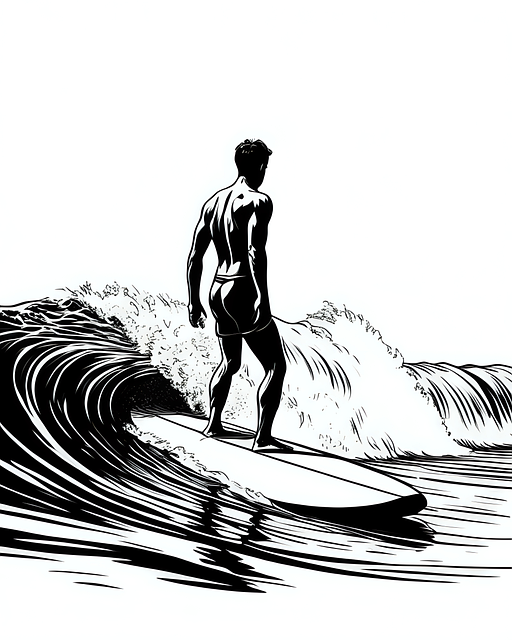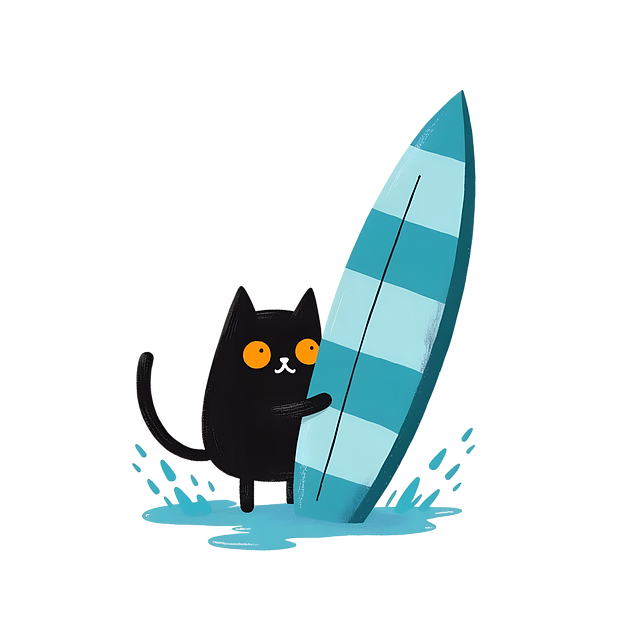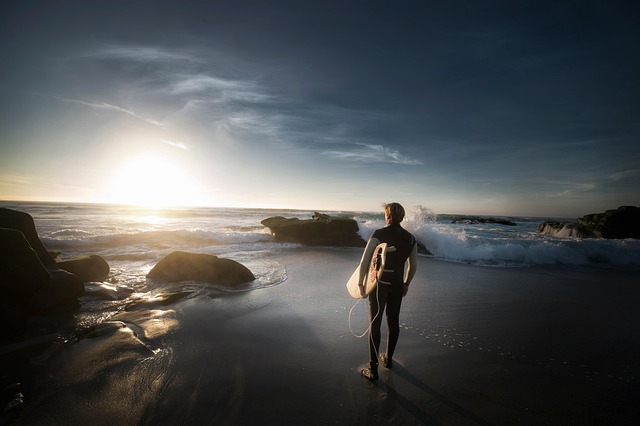For surfboard-buying beginners, understanding three primary wave types—beach, point, and reef breaks—is essential. Each creates unique wave characteristics suitable for different skill levels. Selecting a board aligned with your preferred conditions enhances the surfing experience. Key features for beginner boards include wider noses/tails for stability, rounded edges, soft foam cores, non-slip decks, and removable/adjustable fins. Choosing a versatile board that suits all wave types is ideal, offering stability and ease of learning. As skills advance, transition to more specialized board shapes tailored to power or size of waves. The right surfboard boosts confidence, enhances the overall surfing experience, and enables progress at a comfortable pace. Tailoring your board to local conditions and skill level ensures success and enjoyment. Avoiding common mistakes like choosing incorrect length/weight or peer influence is crucial. Proper care and maintenance extend your board's lifespan through regular cleaning, sunlight protection, and checks for damage.
Looking to conquer the waves but not sure where to start? This comprehensive guide is tailored for aspiring surfers, focusing on the ultimate companion—the surfboard for beginners. We demystify the world of wave types, design intricacies, and crucial features, ensuring you make an informed choice. From selecting the ideal board for your skill level to maintaining its longevity, this article covers all aspects of choosing and mastering your first surfboard. Get ready to ride the waves with confidence!
Understanding Different Wave Types: A Beginner's Guide

For a beginner looking to buy a surfboard, understanding different wave types is key to making an informed decision. There are three primary types: beach breaks, point breaks, and reef breaks. Beach breaks occur along shallow coastal areas with sandy bottoms, creating smooth waves that are perfect for longboarding or learning to catch your first waves. Point breaks, on the other hand, form when waves break over a gradual slope extending from shallow to deep water, ideal for intermediate surfers looking to enhance their maneuvers. Reef breaks happen near coral reefs or rocky shores, producing powerful and complex waves suitable for advanced surfers who want to try cutting-edge techniques.
Choosing a surfboard that matches your wave preference ensures a more enjoyable surfing experience. For instance, a longboard is well-suited for beach breaks due to its stability and glide, while shortboards excel at point breaks for their agility and speed. Reef breaks call for fish or gun surfboards, designed with specific fin setups to handle the powerful waves. As a beginner, it’s best to start with a board that suits your desired wave types and gradually upgrade as you progress and explore different surfing conditions.
The Role of Surfboard Design in Performance

A well-designed surfboard plays a pivotal role in enhancing performance, especially for surfboarders, from novices to seasoned pros. The key lies in understanding that different wave types demand tailored designs to optimize speed, maneuverability, and control. For beginners, a surfboard with a wider nose and tail offers stability, making it easier to catch waves and maintain balance. This design facilitates learning by providing buoyancy and reducing the risk of getting caught in the fin or hitting the board on the water’s surface.
As skill levels advance, surfboards evolve to accommodate more complex maneuvers. For example, smaller, narrower boards enable greater speed and agility, ideal for performing sharp turns and cutting through waves. Advanced designs incorporate specific shapes, fins, and materials to cater to different surfing styles, ensuring that every wave type has a suitable board to maximize performance and enjoyment.
Key Features to Look For in a Surfboard for Beginners

When choosing your first surfboard, it’s crucial to look for features that cater to both learning and performance. For beginners, stability is key; opt for a board with a wider nose and tail, providing better balance and making it easier to paddle out and catch waves. The shape should be user-friendly, often with rounded edges, to minimize the risk of snags and falls.
Consider boards with soft, beginner-friendly foam cores, which offer buoyancy and are less likely to dent or break upon impact with rocks or reefs. A smooth, non-slip deck surface will also enhance your learning experience by preventing slips while standing. Lastly, look for fins that are removable and easily adjustable; this allows you to experiment with different fin setups as you improve, ensuring your board keeps up with your growing skills.
Choosing the Right Board for Your Skill Level and Wave Conditions

When it comes to selecting a surfboard, choosing one suited for all wave types is a popular option, especially for beginners. The key lies in finding a board that offers versatility and stability across various conditions. For novice surfers, a longer board with a wider nose is ideal. These designs provide excellent floatation, making it easier to catch waves and maintain balance. Such surfboards are often referred to as all-rounders or fish boards, perfect for those learning the basics of riding waves.
As your skills progress, you can experiment with different board shapes and sizes tailored to specific wave conditions. For larger, more powerful waves, shorter boards with a sharper nose offer quicker turns and enhanced maneuverability. In contrast, smaller waves call for longer boards that provide stability and glide. Whether you’re facing consistent swells or unpredictable surf, there’s a surfboard designed to suit your needs, ensuring an enjoyable surfing experience at every skill level.
Popular Surfboard Shapes and Their Suitability for All Levels

When it comes to choosing a surfboard, one of the most common decisions is selecting the right shape. Each design caters to different surfing skills and wave conditions, making some boards more suitable for beginners than others.
For newcomers to the sport, a fish or funboard is an excellent choice. These boards are wider and shorter, providing stability and ease of paddling. Their flexible nature makes them ideal for gentle waves, allowing beginners to catch more waves and build confidence. In contrast, longer, thinner boards like guns or mallets are designed for experienced surfers tackling powerful, large waves. While they offer high performance, these boards require more skill and strength to manoeuvre. As a beginner, you’ll likely prefer a board that offers forgiveness and stability, making it easier to learn the basics without feeling held back by the equipment.
Tips for Gaining Confidence on the Water with the Right Board

Gaining confidence on the water is a significant step in your surfing journey, especially when choosing the right surfboard can make all the difference. For beginners, selecting a board that suits your wave type and skill level is crucial. A longer, wider board with more buoyancy is an excellent choice for smaller or gentler waves, providing stability and ease of paddling. These boards are often referred to as longboards and are perfect for learning the basics, allowing you to catch more waves and improve your balance.
As your skills develop, consider a shorter, more manoeuvrable board designed for faster, more powerful waves. These boards, commonly known as shortboards, offer greater agility and speed, enabling beginners to perform turns and navigate more challenging conditions with increased confidence. Remember, the right surfboard will not only boost your self-assurance but also enhance your overall surfing experience, allowing you to progress at a comfortable pace and have fun in any wave condition.
Case Studies: Success Stories of Beginners on Various Boards

For many aspiring surfers, finding the right surfboard can make or break their experience. Case studies from around the globe highlight the success stories of beginners who took their first waves with specialized boards designed for novice riders. These success stories underscore the importance of choosing a surfboard that matches not only one’s skill level but also the local wave conditions.
Beginners on coastal areas known for consistent swells often opt for longboards, renowned for their stability and ease of learning. On the other hand, those in regions with more varied waves might choose shortboards, offering greater agility and maneuverability once they’ve grasped the basics. These diverse experiences demonstrate that a surfboard tailored to an individual’s needs can significantly enhance their surfing journey, making it accessible, enjoyable, and ultimately, successful.
Common Mistakes to Avoid When Selecting Your First Surfboard

When selecting your first surfboard, many beginners make common mistakes that can hinder their learning experience. One of the most frequent errors is choosing a board that’s too long or heavy, making it difficult to maneuver and catch waves. Beginners often assume that a longer board provides more stability, but this isn’t always the case; shorter, wider boards are often better suited for learning as they offer improved agility and easier turns.
Another mistake is selecting a surfboard based solely on aesthetics or what your friends have. It’s crucial to consider your skill level, body type, and the local wave conditions when making this decision. For instance, if you’re petite and living near big, powerful waves, a longer board might not be ideal; instead, opt for something shorter and more responsive that can cut through larger swells. Always seek expert advice or rent various boards to gain experience before committing to your first purchase – it’s a key step in ensuring a positive and successful surfing journey as a beginner.
Maintenance and Care: Extending the Lifespan of Your Surfboard

Surfing is a captivating sport that requires consistent practice and care, especially when it comes to maintaining your surfboard. For beginners, understanding the basics of board maintenance can significantly extend its lifespan. Regular cleaning and conditioning are essential; after each use, rinse your board with fresh water to remove salt residue, which can cause damage over time. Using a soft cloth or sponge, gently wipe down the surface, paying special attention to the fins and any other vulnerable areas.
Protecting your surfboard from direct sunlight is another critical step in its care routine. UV rays can break down the board’s material, leading to cracks and weak spots. Consider storing it in a cool, dry place or using protective covers when not in use. Additionally, regular checks for any signs of damage, such as chips, cracks, or delamination, are vital. Addressing these issues promptly will ensure your surfboard remains in top condition, providing a better surfing experience for years to come, especially for those new to the sport who want a durable and reliable board.
